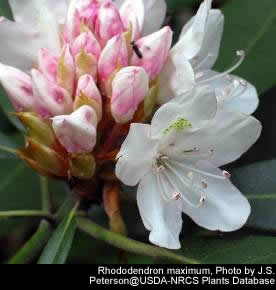

MOUNTAIN STATE FLORA: Rhododendron, Our State Flower By Rose Sullivan Recently, the beautiful and showy Rhododendron maximum celebrated the Centennial of its designation as West Virginia's state flower. There are many names for this state treasure and member of the heath family that is characterized by its large dark evergreen leaves and delicate pale pink or white blooms. The many common names for this shrub include rosebay, rosebay rhododendron, big laurel, great laurel, great rhododendron and white rhododendron. The Rhododendron maximum was selected by the Legislature to be our state flower in 1903 and was the result of a vote by public school students. The range of rhododendron extends along the Appalachians from Georgia north to New England, and also in parts of Canada . In 1736, Peter Collinson and John Bartam introduced Rhododendron maximum to England, selling plants to gardeners in London with hopes of financing future plant expeditions. Bartam later became the King's botanist in America. However, his laurel never became a favorite of gardeners in England because of its small flowers. The rhododendron is characterized by having rose pink or white showy flowers that form large round clusters and bloom in June to July. Its leaves are simple, alternate, up to nine inches long, elliptical in shape and have a leathery texture. The fruit is a sticky capsule. Rhododendron are found in ravines, shaded hillsides in cool moist locations, and favor acidic soils. They often grow in dense thickets that can become impenetrable. These thickets may cast so much shade that other species of plants and trees are eliminated from the understory. Though not a commercial product, the wood is used in making small craft items such as briar pipes. It easily regenerates through root suckers, sprouting from stumps, or from layered stems after it has been cut or even burned. Rhododendron exhibit an unusual and distinctive adaptation to cold temperatures. The leaves droop and roll lengthwise. The colder it gets the tighter the roll gets until the leaves have the shape of hollow slender cylinders. This may be a way for the tree to minimize water loss, especially in dry winter winds. Since the use of common names leads to confusion we need to address another beautiful member of the heath family that can be confused with Rhododendron maximum. Kalmia latifolia is a smaller shrub that has many common names but is often called mountain laurel or ivy. Kalmia latifolia has smaller leaves (3/4 to 1 inch across) than great laurel and small, candy-striped white or pinkish flowers. It blooms in rocky woods during May to July, and at 5 to 15 feet, is smaller in stature than the great laurel. Another relative that is also sometimes called mountain laurel is the Catawba rhododendron (Rhododendron catawbiense). Its darker pink or purple flowers are more common in southern WV. One thing that all three “mountain laurels” of the heath family have in common is their beautiful evergreen foliage and their toxicity to humans or livestock if eaten. Rose Sullivan is the DNR's WildYards coordinator stationed in Elkins. |
